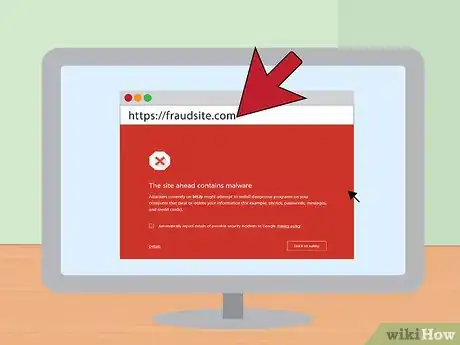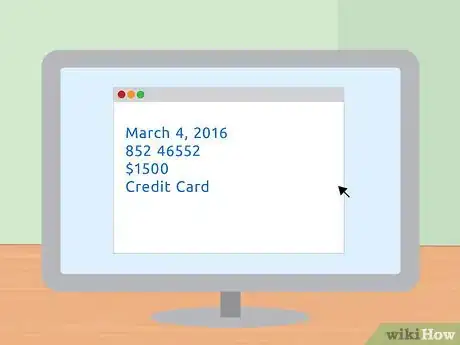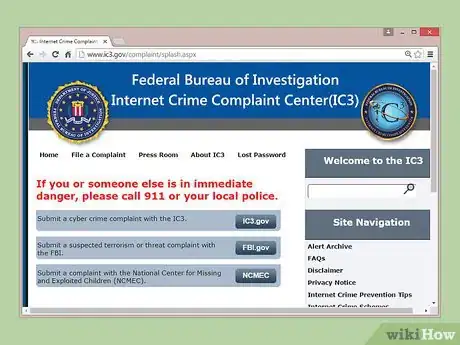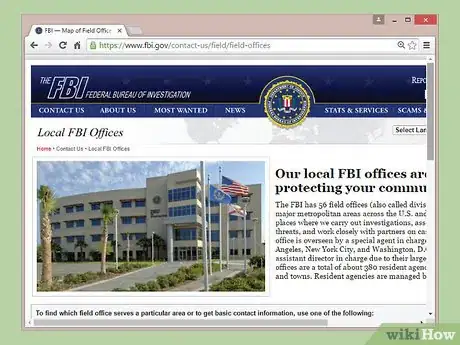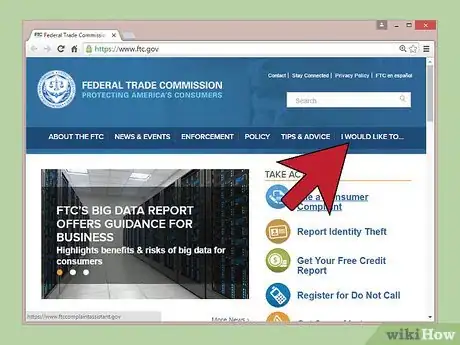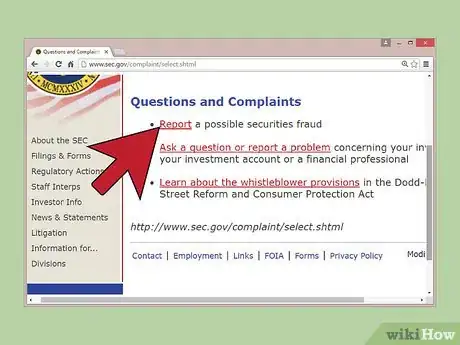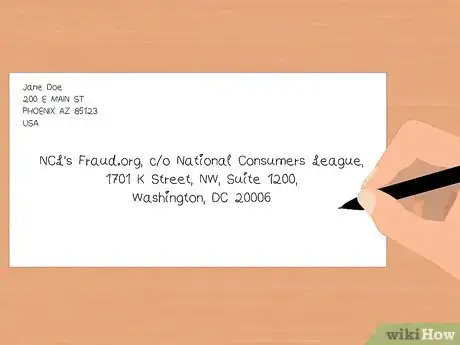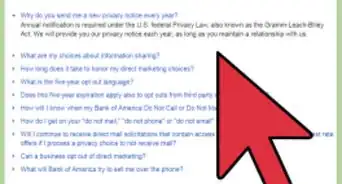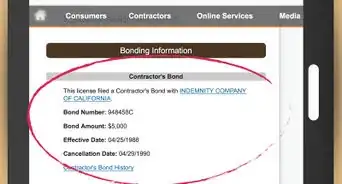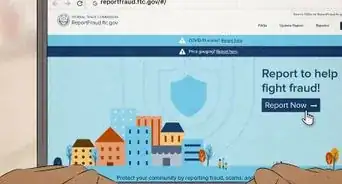This article was co-authored by Clinton M. Sandvick, JD, PhD. Clinton M. Sandvick worked as a civil litigator in California for over 7 years. He received his JD from the University of Wisconsin-Madison in 1998 and his PhD in American History from the University of Oregon in 2013.
There are 15 references cited in this article, which can be found at the bottom of the page.
The wikiHow Tech Team also followed the article's instructions and verified that they work.
This article has been viewed 187,526 times.
Scammers use websites to defraud people in a variety of ways. For example, they may sell people goods and services which are never delivered. Or they may collect personal or financial information in order to commit identity theft. All internet-related crime should be reported to the appropriate authorities to investigate so that more people do not become victims.
Steps
Preparing to Report the Fraud
-
1Understand internet crime. Internet crime is any illegal activity that involves the internet, such as websites, chat rooms, or email. Internet crime entails using the internet to make false or fraudulent representations to consumers.[1]
- Common examples of internet fraud include employment/business opportunity schemes that are fraudulent and the non-delivery of goods or services that you have paid for.
-
2Note the website’s address. To successfully report a website for fraud, you will need to know the website’s URL.[2] Write it down or, if you are at the website, copy and paste the URL into a blank word processing document.
- The URL is the internet address. You can find it by looking in the address bar.
Advertisement -
3Document the fraud. You should write down as much information as possible about the website or any transaction you had with the website. For example, you should document as best you can the following:[3] [4]
- the dates you communicated with the company
- any phone number listed on the website
- a description of what services or goods the company was offering
- the amount charged by the website and the amount you paid
- your method of payment
- a short description of what happened
-
4Protect yourself. If you think that you have accidentally given out identifying or financial information, then you should take actions to protect yourself. This information includes your Social Security Number, date of birth, bank account information, or credit card numbers.
- If your Social Security Number was exposed or stolen, then you should get a free annual credit report from annualcreditreport.com and check to see if any new accounts have been opened under your name.[5]
Because scammers can try to open credit card accounts with your Social Security Number, you might want to request a credit freeze.
- A credit freeze restricts access to your credit report. Because most creditors want to see your credit report before opening a new account, the freeze can prevent scammers from obtaining credit in your name.[6]
- To request a freeze, you should contact each of the three national credit reporting companies: Equifax, Experian, and TransUnion. You will have to pay a fee, which can range from $5 to $10.[7]
- If your debit or credit card number was stolen, then contact your bank or credit card company and cancel your card. You can then request a new one. Alternately, you could simply monitor your statements regularly and report any suspected fraud to the credit card company.[8]
- If your bank account information was stolen, then you can contact your bank to close the account and then open a new one. If you don’t want to close the account, then you should regularly monitor your bank statements.[9]
- If your Social Security Number was exposed or stolen, then you should get a free annual credit report from annualcreditreport.com and check to see if any new accounts have been opened under your name.[5]
Because scammers can try to open credit card accounts with your Social Security Number, you might want to request a credit freeze.
Reporting the Fraudulent Website
-
1Choose an agency to report to. You have several options for reporting internet-related fraud. For example, the Department of Justice recommends that you contact one of the following:[10]
- local FBI office
- Federal Trade Commission
- Internet Crime Complaint Center
- Securities and Exchange Commission, if the fraud is related to securities or investments
-
2Report to a local FBI office. You can report website fraud to any of the FBI’s 56 field offices around the country. To find the nearest office, you can search using your state or zip code at https://www.fbi.gov/contact-us/field/field-offices.
- Once you have found the nearest office, you can call or email the office. The contact information should appear on the field office’s website.[11]
-
3Report fraud to the Federal Trade Commission (FTC). You can also report website fraud to the FTC by filling out an online complaint. Go to www.ftc.gov and then click on “I Would Like To…” at the top, right-hand side of the screen. Select “Submit a Consumer Complaint to the FTC.” Then click on the link to ftc.gov/complaint.
- You will then select a category of complaint. For website fraud, you should select “Scams and Rip-offs.”[12]
- Answer the Complaint Assistant’s questions. The Assistant will lead you through a serious of questions to help gather necessary information. You may also chat with a specialist Monday through Friday, from 9:00 am to 8:00 pm Eastern Standard Time. To initiate a chat, click on the “Click here to chat with a Technical Support Specialist” icon.
-
4Report to the Securities and Exchange Commission (SEC), if necessary. You only need to report to the SEC if the website fraud involves the sale of securities or investments. To reach the SEC, visit http://www.sec.gov/complaint/select.shtml.
- Click on the “Report” hyperlink to report possible securities fraud.
- Then click on the “Tips, Complaints and Referrals Portal” before clicking “I Accept.” You can then submit information by clicking on the “Questionnaire” link at the top or the “click here” link in the third paragraph.
- After you submit your information, SEC will perform a confidential investigation. The agency may use the information you provide in any civil or criminal enforcement action.[13]
-
5File a complaint with the Internet Crime Complaint Center (ICCC). Visit the website at www.ic3.gov and click “File a Complaint” at the top of the screen. The ICCC is a partnership between the Federal Bureau of Investigation and the National White Collar Crime Center.[14] After processing the complaint, the ICCC then forwards the complaint on to the appropriate federal, state, local, or international enforcement authority.[15]
- Read the information about filing a complaint and then click “I Accept.”
- You should then supply your information on the referral form.[16]
-
6Contact Fraud.org. You also have the option of reporting the website fraud to www.fraud.org, which is a project of the National Consumers League. Once at the website, you can fill out an online incident report. The organization then forwards the information to the appropriate government agency.[17]
- You also can report the fraud by writing a letter and mailing it to NCL’s Fraud.org, c/o National Consumers League, 1701 K Street, NW, Suite 1200, Washington, DC 20006.[18]
- Send photocopies of any supporting documentation (not originals).
References
- ↑ https://www.ic3.gov/Home/FAQ
- ↑ https://secure.nclforms.org/nficweb/OnlineComplaintForm.aspx
- ↑ https://secure.nclforms.org/nficweb/OnlineComplaintForm.aspx
- ↑ https://www.ic3.gov/Home/FAQ
- ↑ https://www.identitytheft.gov/info-lost-or-stolen
- ↑ http://www.consumer.ftc.gov/articles/0497-credit-freeze-faqs
- ↑ http://www.consumer.ftc.gov/articles/0497-credit-freeze-faqs
- ↑ https://www.identitytheft.gov/info-lost-or-stolen
- ↑ https://www.identitytheft.gov/info-lost-or-stolen
- ↑ http://www.justice.gov/criminal-ccips/reporting-computer-internet-related-or-intellectual-property-crime
- ↑ https://www.fbi.gov/chicago
- ↑ https://www.ftccomplaintassistant.gov/#crnt&panel1-3
- ↑ http://www.sec.gov/complaint/info_tipscomplaint.shtml
- ↑ https://www.ic3.gov/
- ↑ https://www.ic3.gov/Home/ComplaintChoice/default.aspx
- ↑ https://complaint.ic3.gov/default.aspx?
- ↑ https://secure.nclforms.org/nficweb/nfic.htm
- ↑ https://fraud.org/contact-us/

